Iwo Jima.
This is probably the image that comes to your mind when you think of that small island in the middle of the Pacific Ocean:
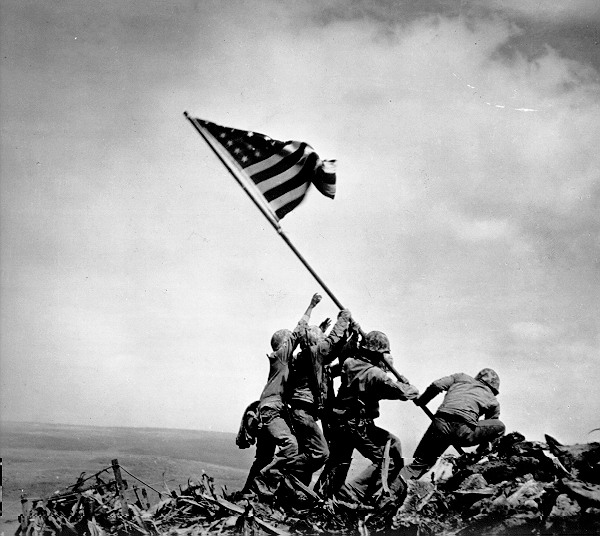
Now, imagine this (the rest of the story):
The date was 18 February 1945, D-Day to capture the critical island of Iwo Jima. This was the next island in line for the “island hopping” campaign for the United States in the Pacific Theater of Operations during World War II. There had already been three days of constant naval and aerial bombardment to “soften” the defenses of the island of Iwo Jima.
These assaults barely scratched the surface.
The invasion force was 70,647 US Marines. They faced 21,000 Japanese forces well entrenched in an intricate network of underground tunnels. The invasion force included a total of 250,000 US forces. They were carried on one of the largest armadas ever assembled, which included more than 800 vessels (12 aircraft carriers, 8 battleships and a host of other support vessels).
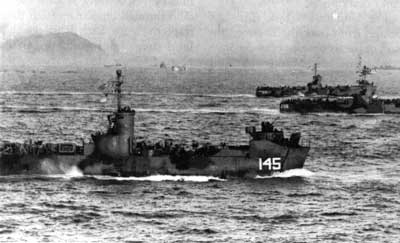
There was a 2 mile stretch of beach that was the only viable landing location. The American planners knew that and the Japanese defenders knew that. So, those 70,000 Marines came in to an area that was incredibly well defended and further complicated by soft, black volcanic beaches. So, the first wave got bogged down as they came ashore, then 5 minutes later another group was right on their heels, and another after that, and another, and so on. However, for the first hour, the Marines only encountered relatively light resistance. This is not what they were expecting. Once the beach had become congested though, the Japanese defenders opened up and decimated the men and equipment on the beach while remaining seemingly invisible from their underground or concealed emplacements. A book (Iwo Jima: Legacy of Valor) by Bill Ross described it as, “mortars fell cascades from hundreds of concealed pits. Heavy artillery and rapid-firing antiaircraft guns, barrels lowered to rake the beaches, slammed shells into oncoming landing craft and support vessels. Land mines sown like wheat in a field, exploded in sickening blasts as Marines stumbled across them. Fifteen inch guns and large mortars rained down from Suribachi’s base, slopes and crater … 6,200 men were down on the 3,000-yard strip of land.”
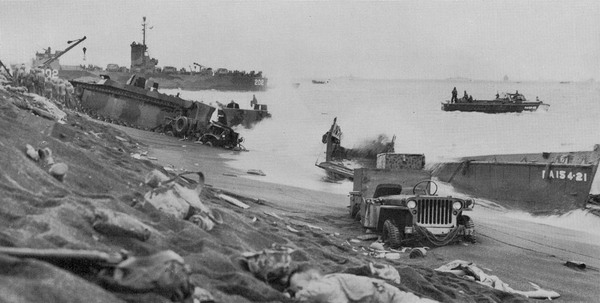
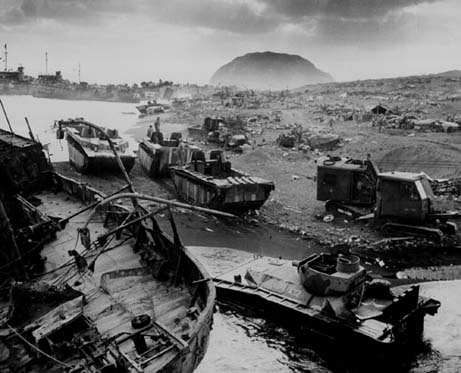
Eventually, the Marines broke free and began to advance inland in force.
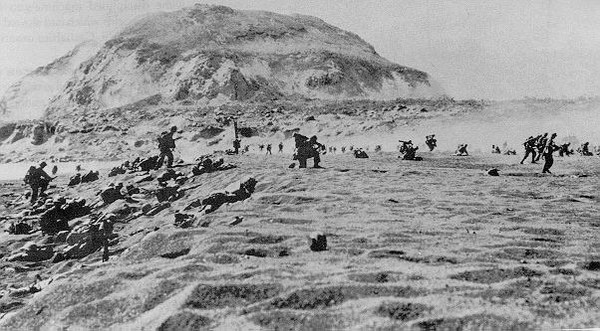
Although the island is less than 8 square miles, it has a formidable natural fortress in the form of Mount Suribachi (A suribachi is a kind of rough grinding bowl. Apparently the mountain’s shape was reminiscent of a suribachi to the Japanese who named it) on the extreme southern end of the island.
On the third day of fighting on Iwo Jima (D+2), the Marines launched their coordinated attack on Mt Suribachi. However, in some places they only advanced 50 yards that day.
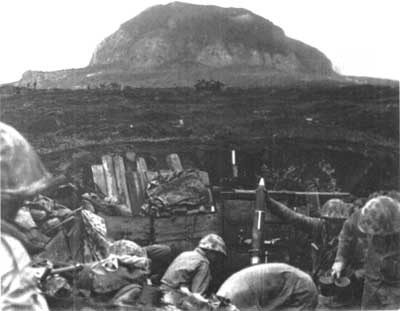
D+3 brought much of the same. There was no room for the supporting tanks and artillery to maneuver and the battle lines were so close that air support was ineffective. The battle raged with the marines fighting above ground and the Japanese fighting below. Many times, the US forces would never see their adversary as they were so well hidden. The most effective tactic was to use flame throwers and hand grenades.
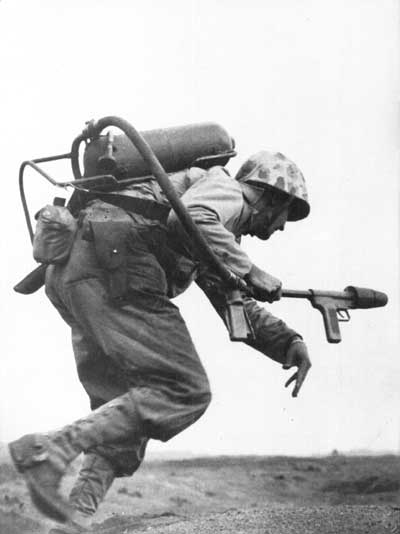

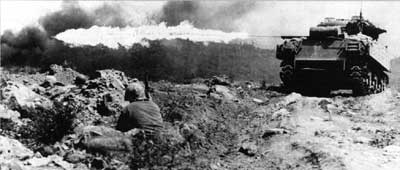
Finally on D+4 (24 February 1945), a forty man patrol was sent out and moved up the northern slopes toward the summit. They engaged a number of Japanese soldiers who attacked with hand grenades, but at 10:30 AM, the stars and stripes were raised on a length of pipe.
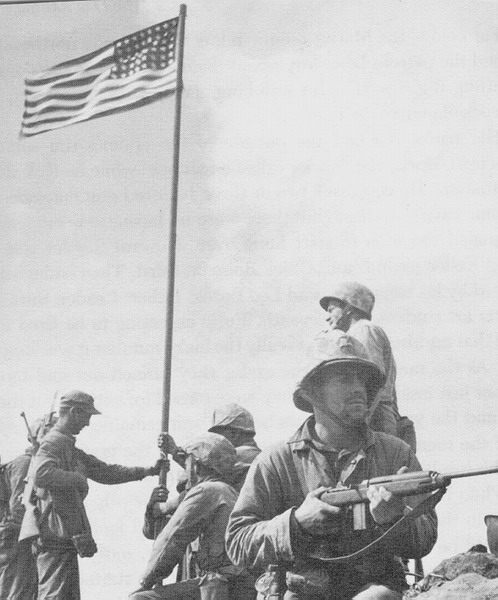
Photographer Lou Lowery captured this first flag raising on Iwo Jima on film. The shout went out throughout the southern part of the island “the flag is up!” and the troops cheered while the naval vessels sounded their siren. Around noon, the small flag first raised was replaced by a much larger one. These flag raisers are the ones that photographer Joe Rosenthal forever immortalized in his famous picture. This has become one of the most recognized pictures of the whole war. When asked 10 years later about the picture, he commented. “what difference does it make who took the picture, I took it, but the Marines took Iwo Jima.”
Here is a picture shortly after Old Glory was raised:

While the Marines were justifiably happy, the battle was far from over. The final “organized” attack occurred on 26 March 1945 (36 days after fighting began). 262 Japanese and 53 Americans were killed and at 0800, the island was declared captured.
This, over an island that is 5 miles long and averages only a mile and a half wide. The casualties were almost unbelievable. There were almost 7,000 American killed in the capture of Iwo Jima (of that 6,000 were Marines). Of the 21,000 Japanese defenders, 20,000 were killed and 1,083 were taken prisoner. There were 22 Medals of Honor awarded to Marines and 27 total were awarded, although 13 were posthumous (this is more than 25% of Marine Medals of Honor in all of WWII). The strategic value of the island is significant. Since the island is about halfway between the Marianas Islands and mainland Japan, it was an effective divert base for the many heavy bombers attacking Japan and a base for the shorter range fighters to escort the bombers. By the end of the war, more than 2,400 emergency landings were made at Iwo Jima. That meant that 27,000 men in those B-29s didn’t have to ditch their planes at sea (or worse) and prompted US Navy Admiral Ernest King to state that the lives saved “exceeded lives lost in the capture of the island itself.”
An interesting side note:
The man who led the Japanese defense of Iwo Jima was Lieutenant General Kuribayashi. He had lived and studied in the US during the 1920s and was later an assistant Defense Attaché before WWII. He wrote to his son and said, ” The United States is he last country in the world that Japan should fight. Its industrial potentiality is huge and fabulous, and the people are energetic and versatile. One must never underestimate the American’s fighting ability.” However, he led his forces in an effective, bitter fight to the end. His orders to his men were: don’t expect to survive the battle and to take out 10 Americans before they themselves were killed.
Here is the general:
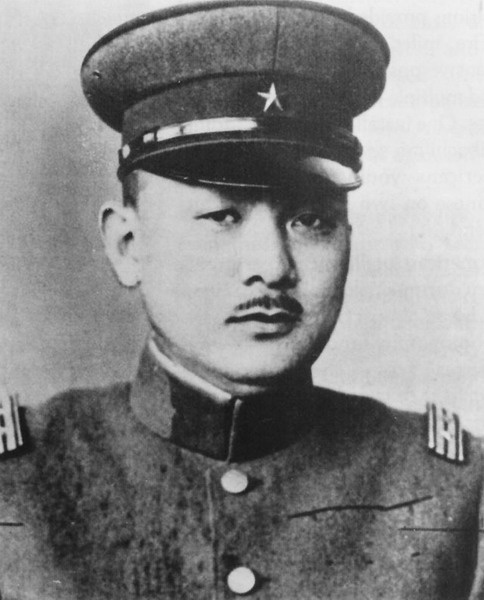
My thanks to the base historian and our Marine guide who educated me on the history which I just shared with you all (and provided the reference material from which to draw upon).
The next entry will discuss our trip to this historic island.
–Jim
Category: Trips
The Land Down Under in 2005 — Part 2
When we arrived in Sydney, we wasted no time in exploring the city. Fortunately, our hotel was right downtown and it’s very easy to navigate around.
We went to the harbour bridge tower to get a better vantage point of the area. Here is one of the most famous landmarks in the world, the Sydney Opera House.
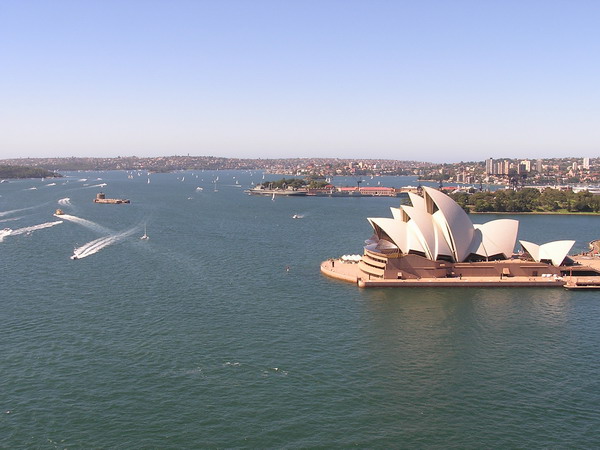
Next to the opera house is a place called Circular Quay (pronounced Circular “Key”). It is the harbour that connects downtown with the outer regions of Sydney by water.
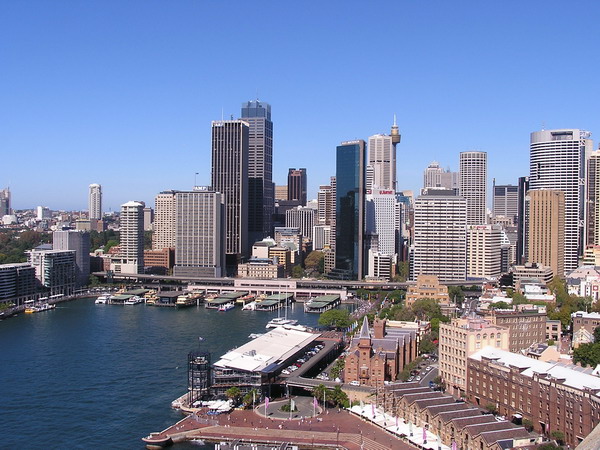
Here is Anna and I on the harbour bridge tower.
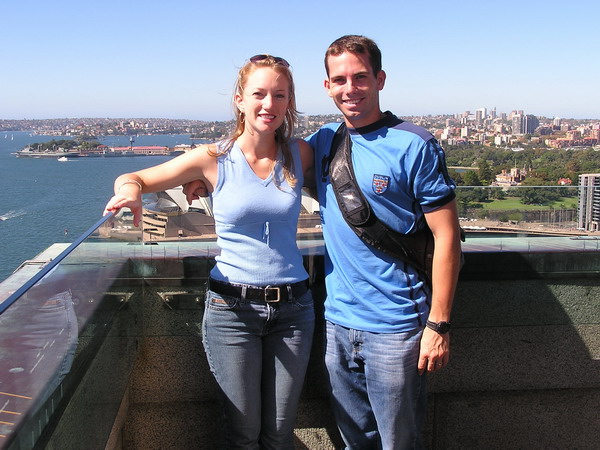
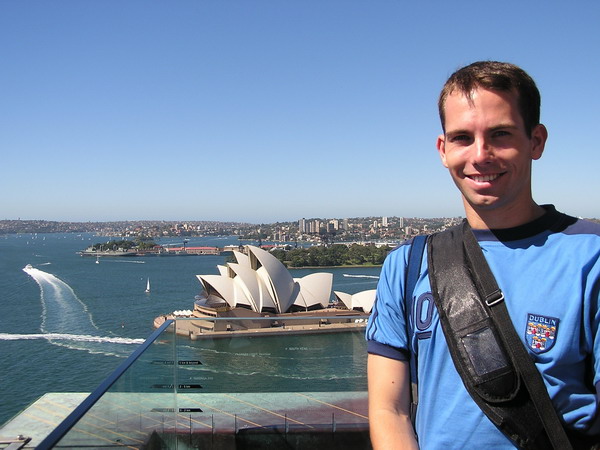
We heard that one of the best things to do (if you’re a little adventurous) is to climb the harbour bridge. This is true and we enjoyed doing it, but it was VERY expensive. If you go and are on a budget, that is one you can skip. Here’s a picture of the bridge. If you look closely, you can see groups of people climbing up the arch on the outside. Perhaps some people feel this is thrilling, but quite honestly, Anna and I were a little disappointed. The best view from the top was only slightly better than from the observation post and you couldn’t even bring your camera with you. Oh well, we’re glad we did it, just wish it were a little less expensive.
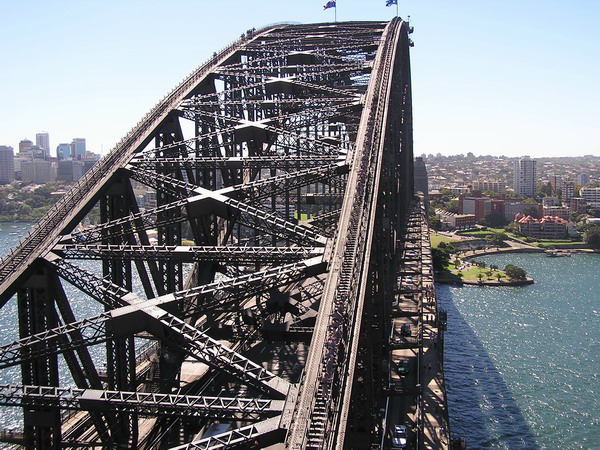
I really liked the arches on the opera house.
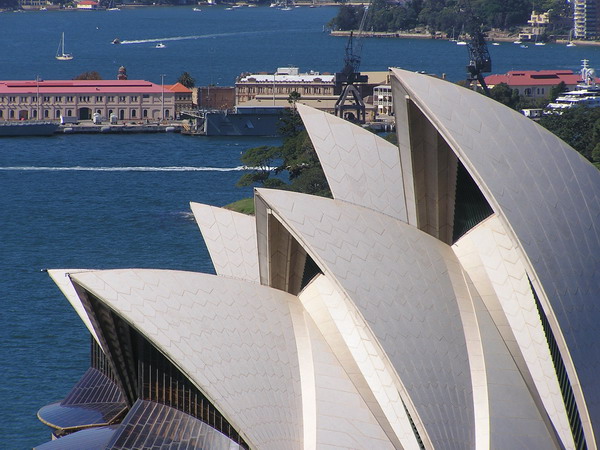
Another destination on our itinerary was Bondi Beach, one of the most famous beaches in the world. Even though the weather wasn’t the best, there were still lots of people out to take in the sun, see and be seen, and of course, surf.
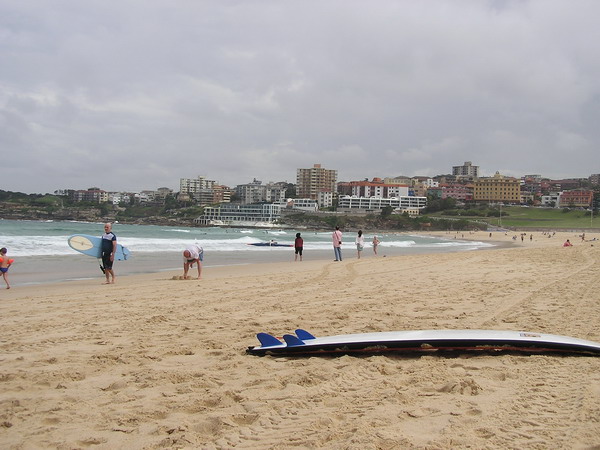
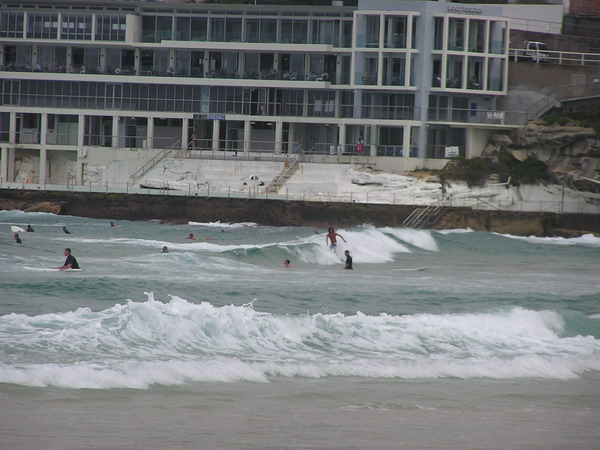
Here’s what Sydney Harbour looks like from the water coming back in from our day at Bondi.
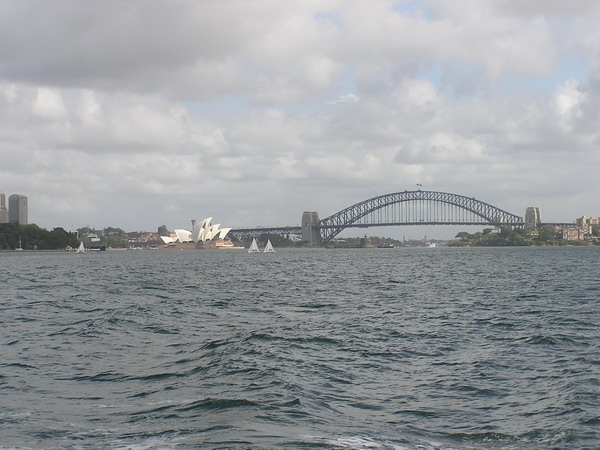
To continue with the beach theme we found, we later headed over to Manly Beach. The weather was nicer, so we took a stroll through the area. Needless to say, it was beautiful.
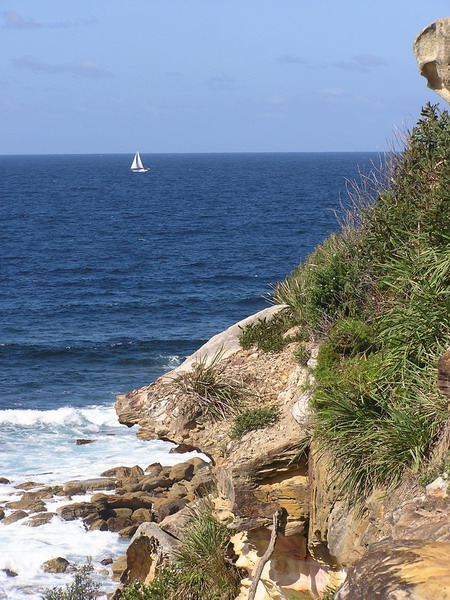
Another activity we simply had to do was see a show in the opera house. While there wasn’t an “opera” to hear, we did get to go see a very nice classical ballet. The acoustics are just about perfect.
Here’s are the sights that greeted us when we were done with the show.
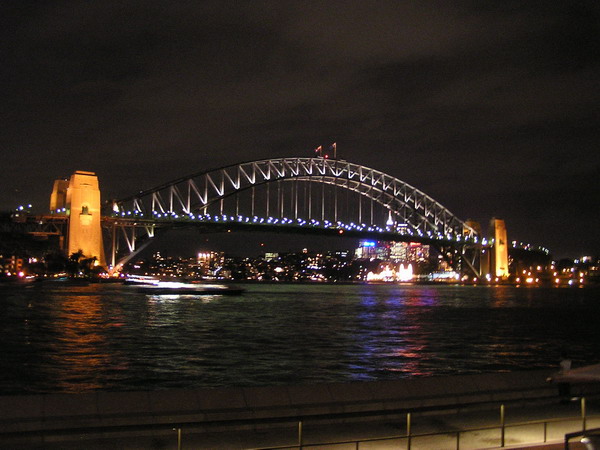
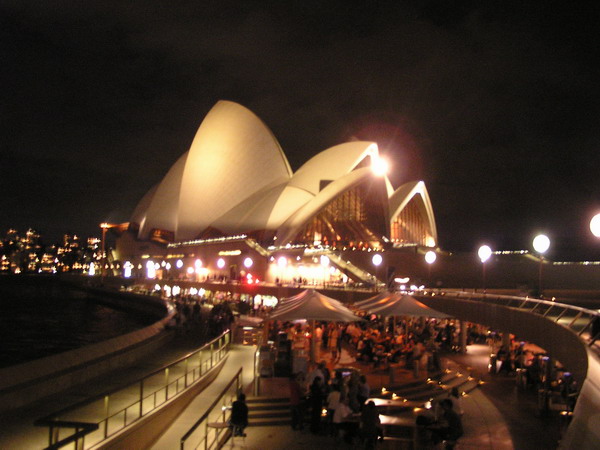
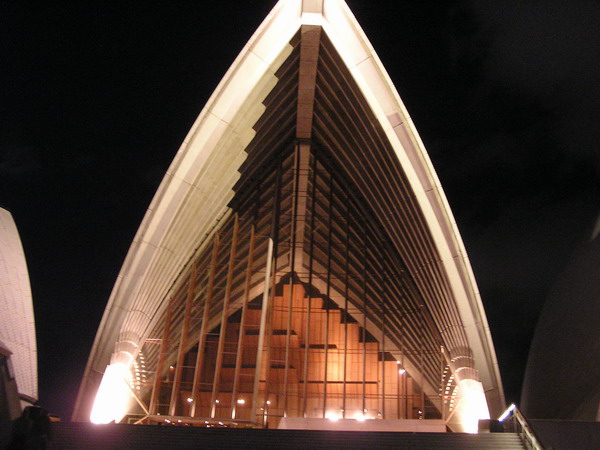
We were also able to get outside Sydney and explore the area a little. We went to another wildlife sanctuary (since we didn’t get enough with the stop at Billabong in Townsville).
This cassowary (found in the far north of Australia) is a very unique looking creature.
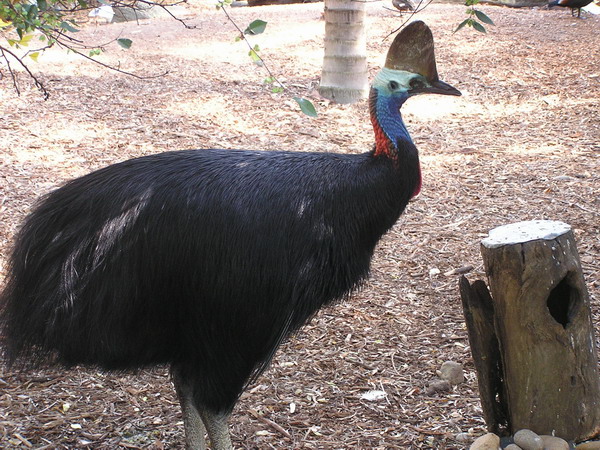
My turn to hold the snake.
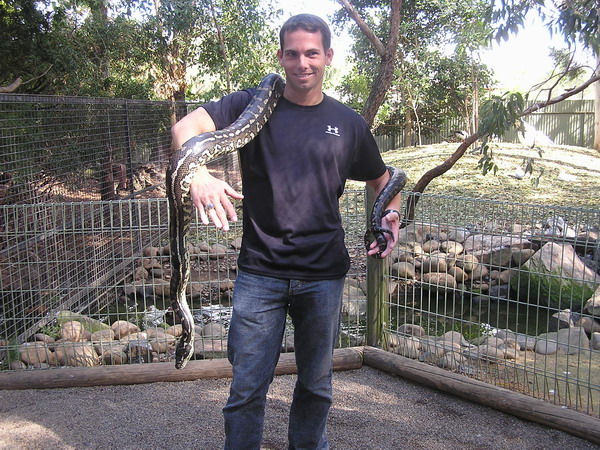
Of course, there were more koalas.

The Kookaburra (seen here, below) has a very unique call. It’s like a loud, eerily human sounding laughter.
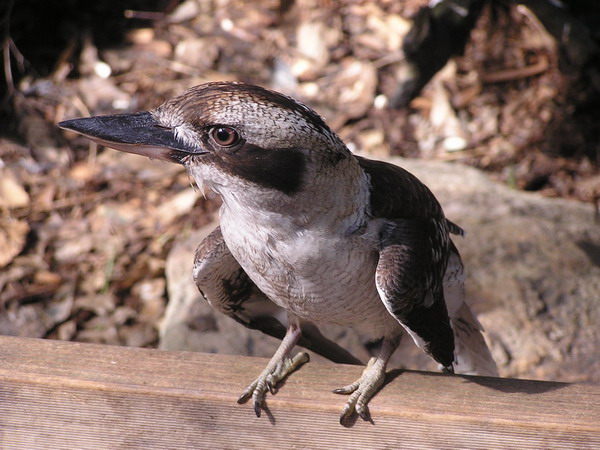
Here’s yet another very unique bird native to Australia, the Tawny Frogmouth. It’s aptly named and the picture doesn’t do it justice, but it’s beak and mouth looks very similar to a frog’s.
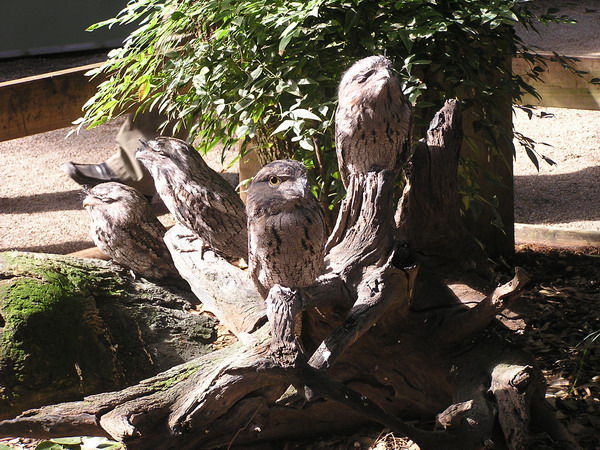
Here are the Frogmouth and Kookaburra together.
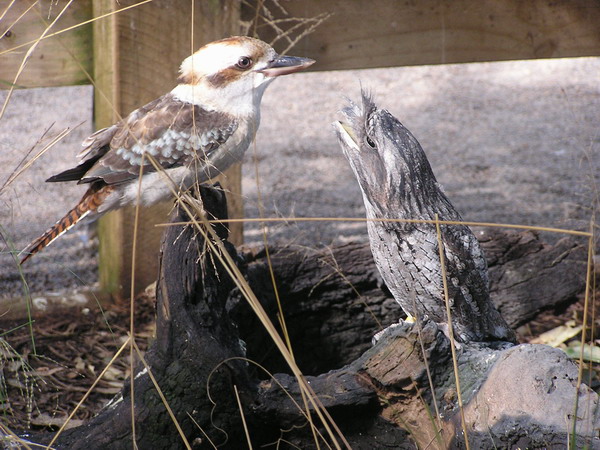
These amorous wallabies were adorable. They are in the kangaroo family, but smaller.
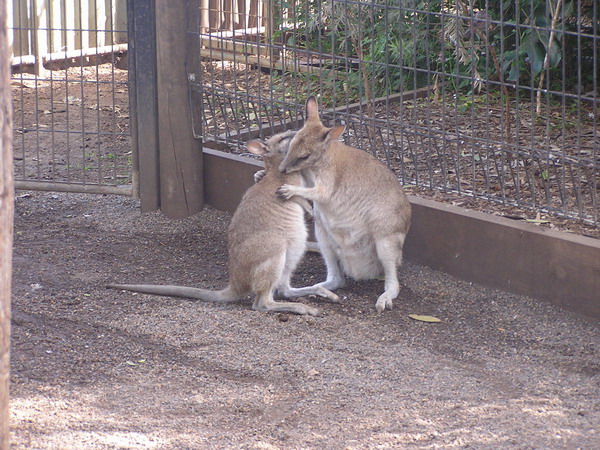
Here’s another wombat. Did you know that they are marsupials that take up to 14 days to digest their food?? Gives new meaning to the idea of a slow metabolism.
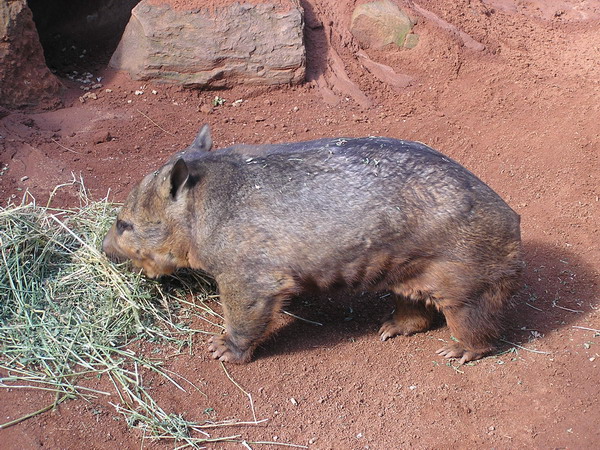
One of the few species of penguin found outside Antarctica is the Fairy Penguin (also known as the Little Penguin). It’s only about 16 inches high and a little over 2 pounds when fully grown.

OK, so I have no idea what type of bird this is, only that it’s very pretty. If you recognize it, please post a comment and let me know. 🙂
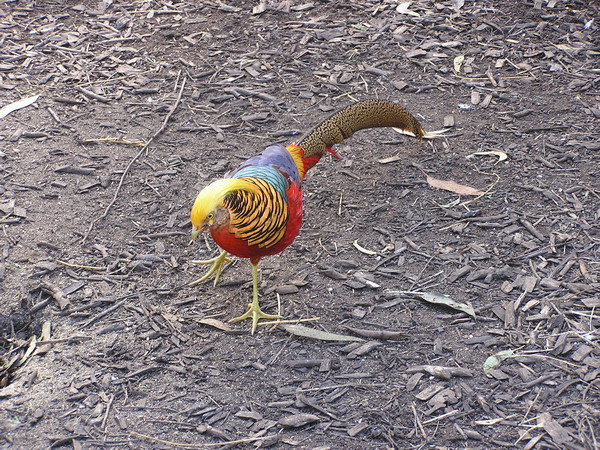
Here’s a cockatoo.
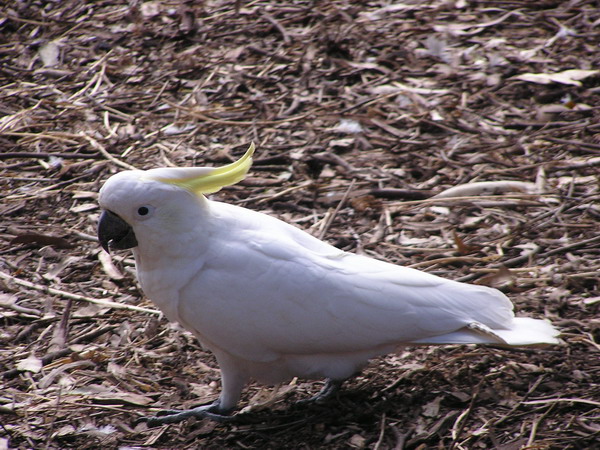
After we finished playing with all the animals, we continued on to the Blue Mountains. We went to visit the most famous landmark, the Three Sisters. They tower over Jamison Valley and are named: Meehni, Wimlah, and Gunnedoo. Indigenous Australian (aboriginal) Dreamtime legend says that three sisters fell in love with three men from a neighboring tribe, but the marriage was forbidden by tribal law. A battle ensued, and the sisters were turned to stone by a witch doctor to protect them. Unfortunately, he was killed in the fighting and no one else could turn them back.
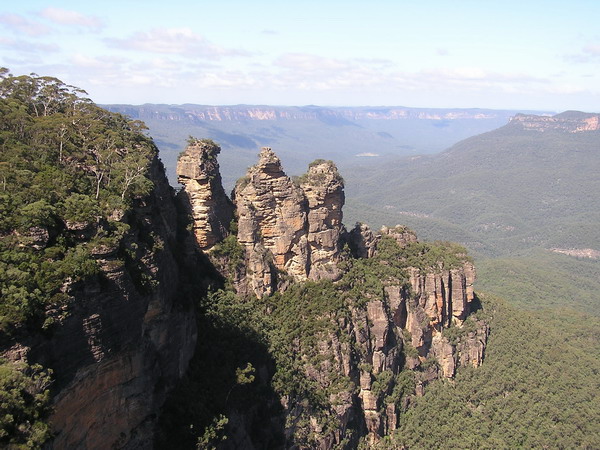
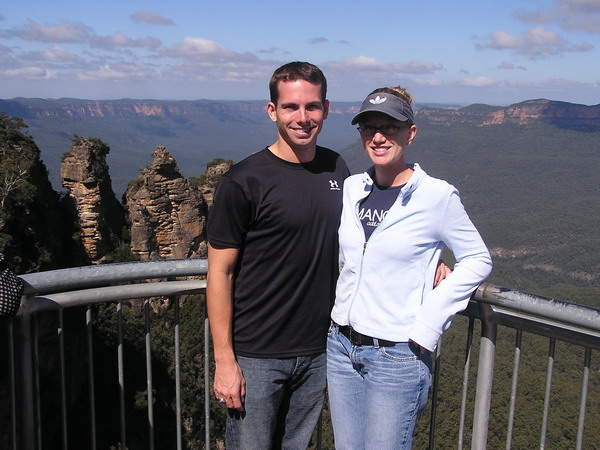
Here’s a view of the valley. The Blue Mountains, aren’t really mountains in the true sense of the word. They are sandstone plateaus that have been eroded to create these spectacular valleys.
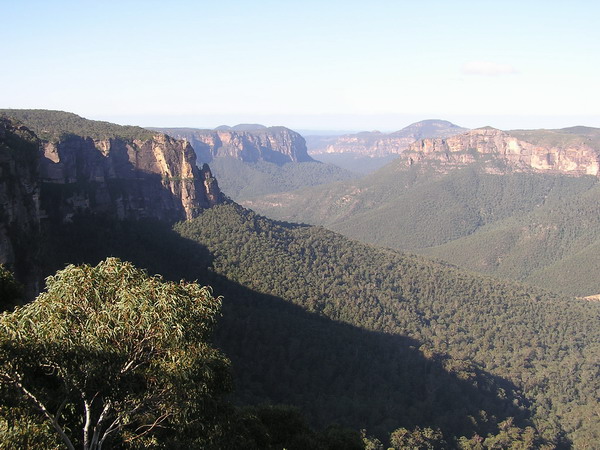
The final picture from our trip to the land down under is a rivercat. These nimble water craft took us rapidly back to Circular Quay.
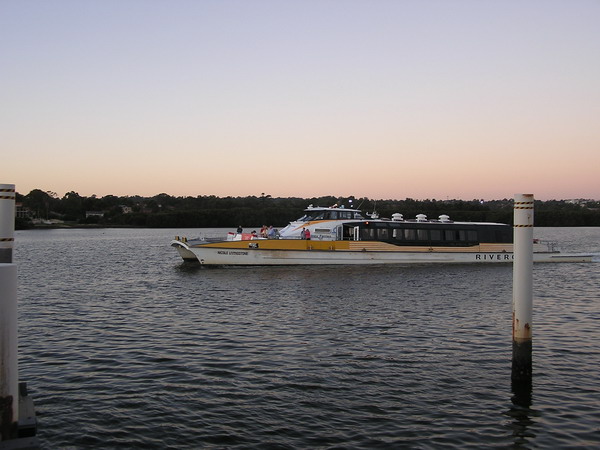
That concluded 2 wonderful weeks in Australia. We’d love to go back right now. Unfortunately, it will be a little while before we make it back. However, until then, the memories and these pictures will have to suffice.
So, until the next adventure…
–Jim
The Land Down Under in 2005 — Part 1
Back in 2005, Anna and I took a trip to the land down under. Since we lived in Guam, it was a pretty short trip. We simply HAD to go because Anna had spent a year in a small city in Northeast Australia called Townsville. So, we decided to take two weeks and visit the towns of Cairns and Townsville for the first week, and Sydney for the second.
Our journey began in the northern tourist mecca of Cairns (pronounced Cannes … like “cans” of soup). It is the only destination in Australia that is a direct flight from Guam and only a 3 hour plane ride.
Australia is a country that is perhaps as diverse as the US. In the north, there are lush tropical rainforests, temperate mountains in the southeast, and arid desert in the center.
Here is a picture of us taking the gondola into the Daintree National Rainforest.
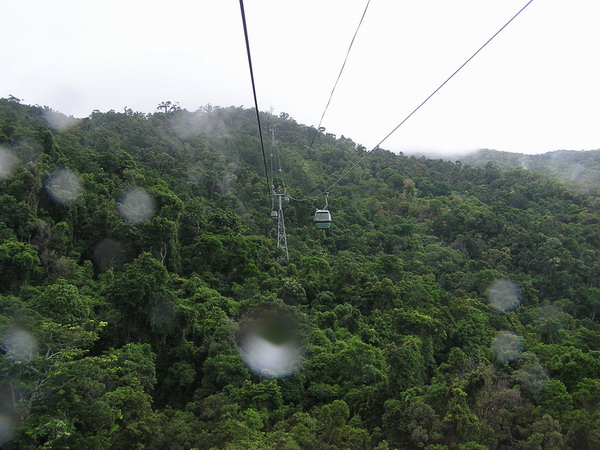
We spent the day exploring the forest and the little village at the top of the mountain, Kuranda Cultural Rainforest Village.
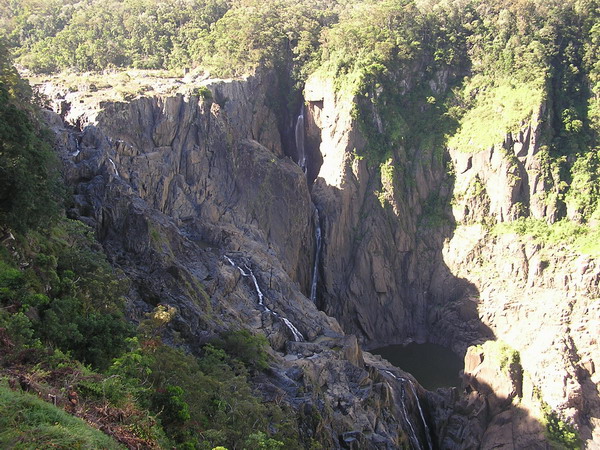
To come back down we opted for a train ride.
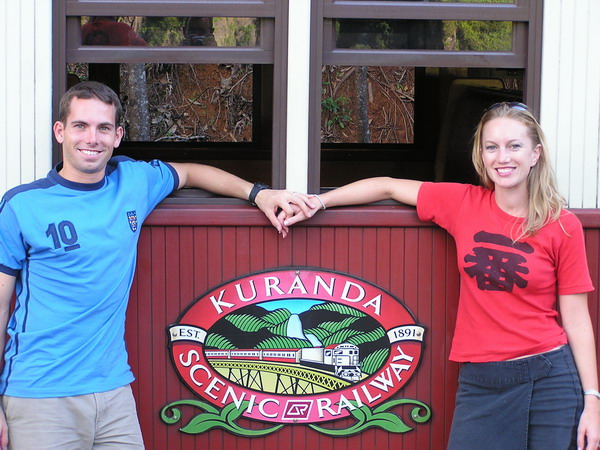
Anna enjoying the landscape slide by:
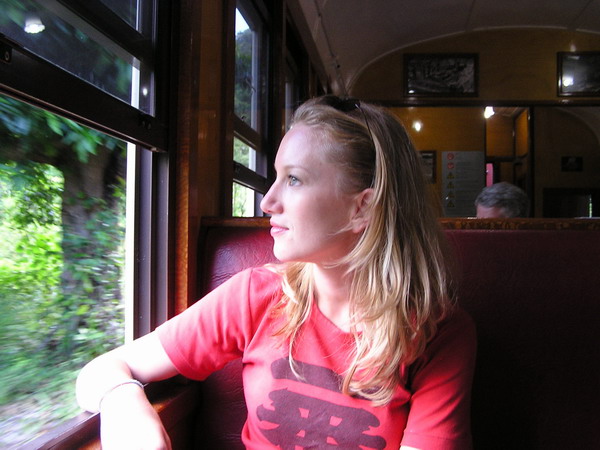
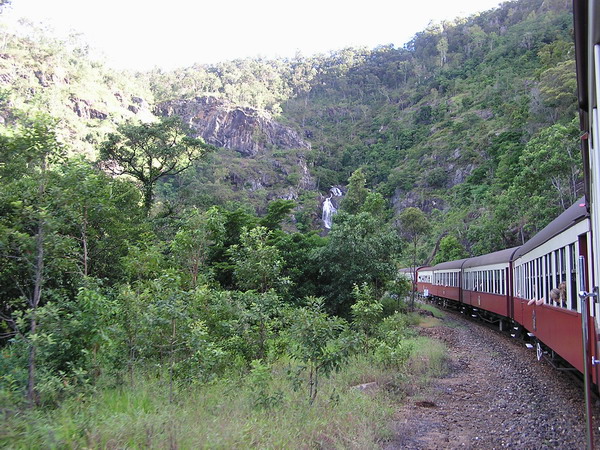
Back in Townsville, we went to the Billabong wildlife sanctuary. It was like a very elaborate petting zoo in the US. Most animals were roaming free and it was great to be able to interact with them. In fact, I even got to hold this wombat in my lap.
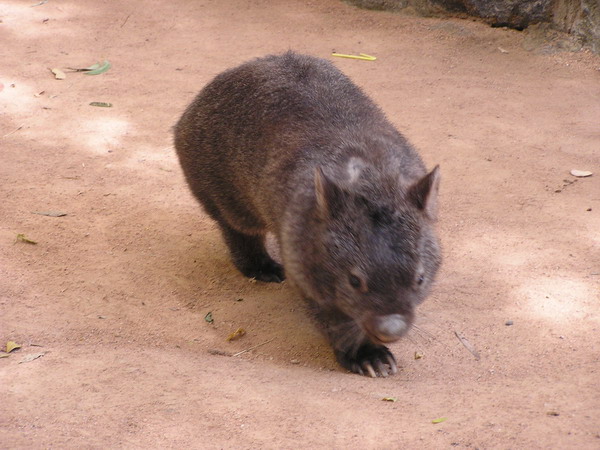
Of course, there were plenty of koalas there to see (and even some to hold!). It’s interesting to note that early European settlers called the Koala the “Native Bear” of Australia. This is a misconception. A koala is a marsupial that is not a bear of any kind. So, if you go, please don’t call them koala bears. 🙂
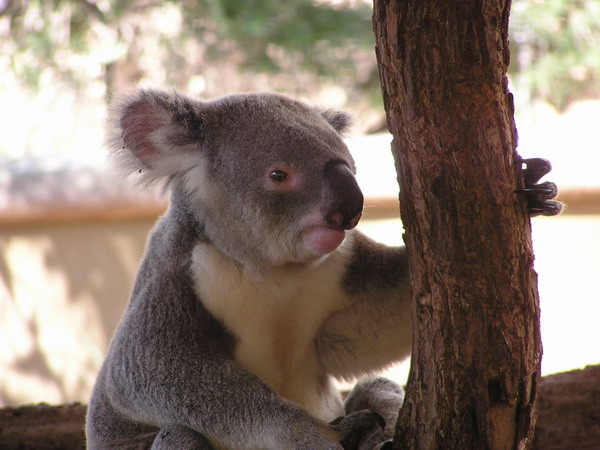
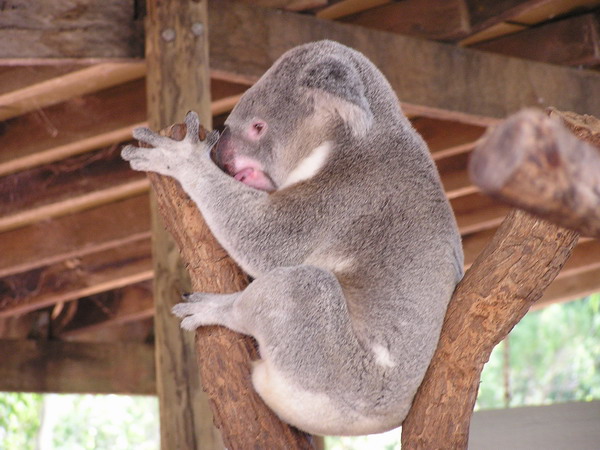
This is one of Anna’s long-time friends that we met with, Janine.
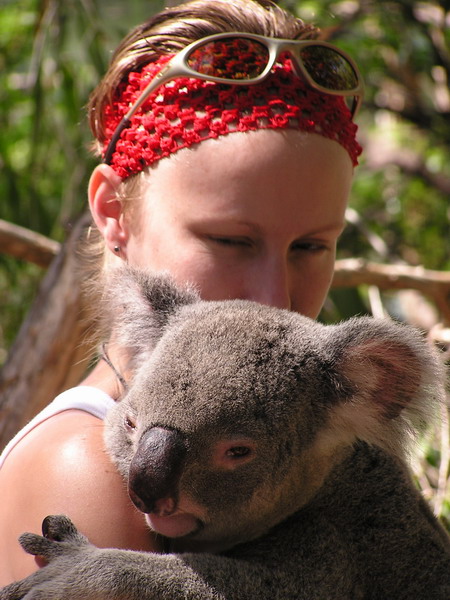
Another picture of Janine holding a very affable koala.
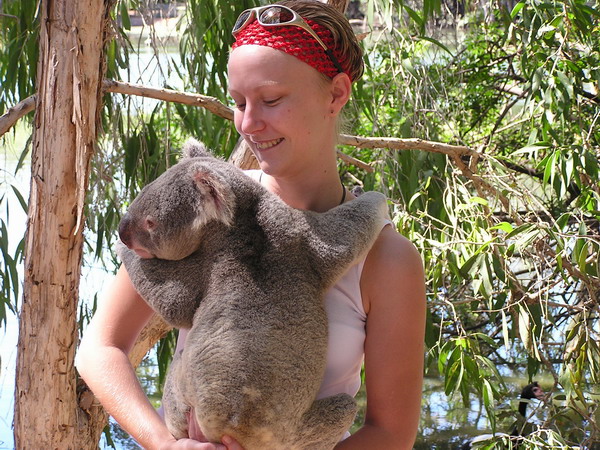
Here’s another very common marsupial in Australia, the kangaroo. I think combined with the koala, these are the quintessential or signature animals of Australia, at least from an American perspective. Oh, you’ll note that the joey (young ‘roo) is still in it’s mother’s pouch.
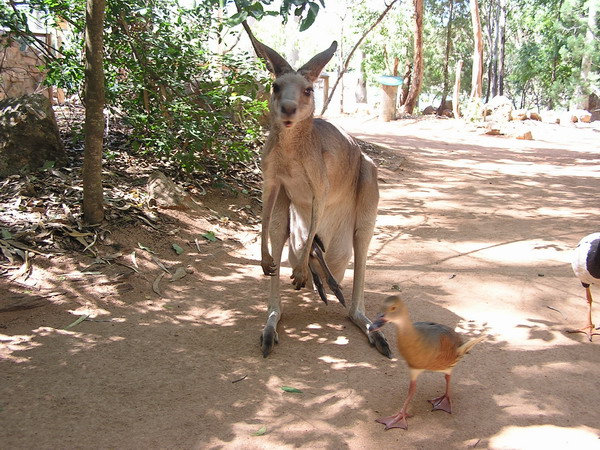
Yes, we even got to feed them. It kind of reminded me of feeding a deer. There is some similarity in the way deer and kangaroos look, plus they are both very shy and retiring by nature.
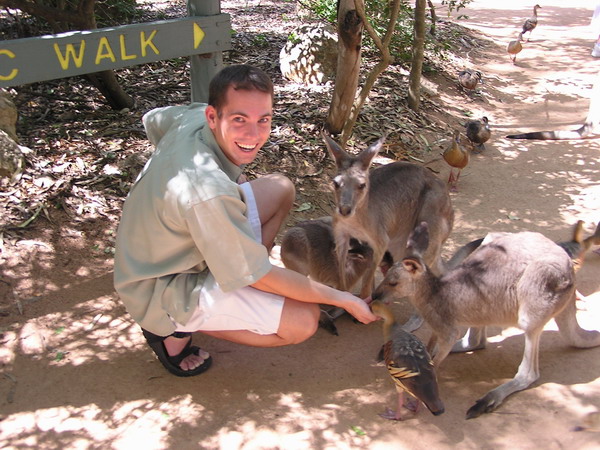
This little croc wasn’t quite as cuddly…
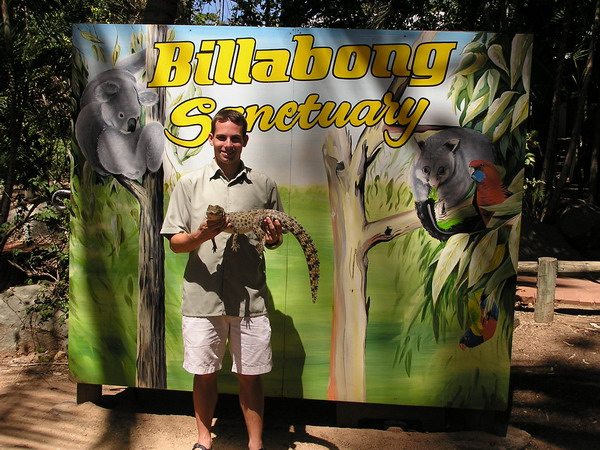
Another interesting fact is that 8 of the world’s 10 deadliest snakes live in Australia. So, if you see one in the wild, there’s a good chance it’s poisonous. Fortunately, this was a python and not dangerous.
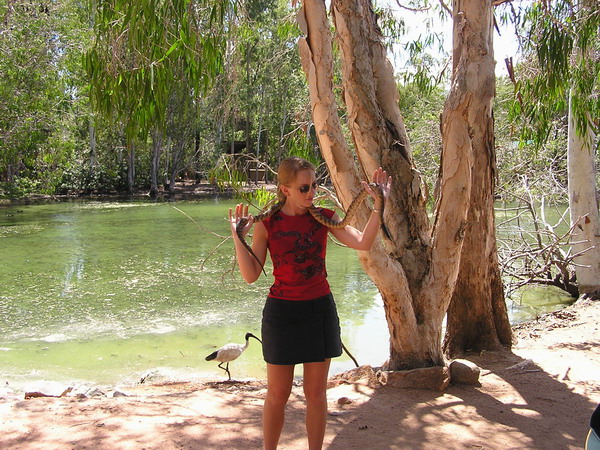
I wasn’t about to hold THIS crocodile…
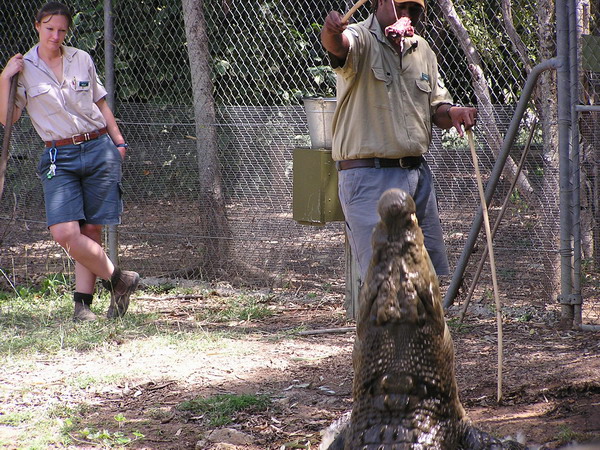
Later that week, we took a ferry out to Magnetic Island, just off shore from Townsville. Here is Anna and I as we hiked from one side to the other:
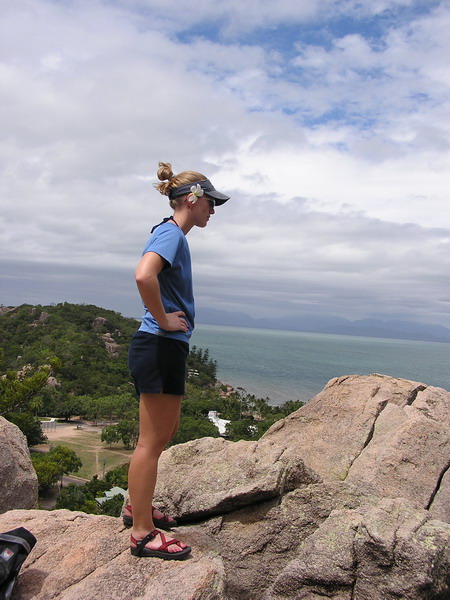
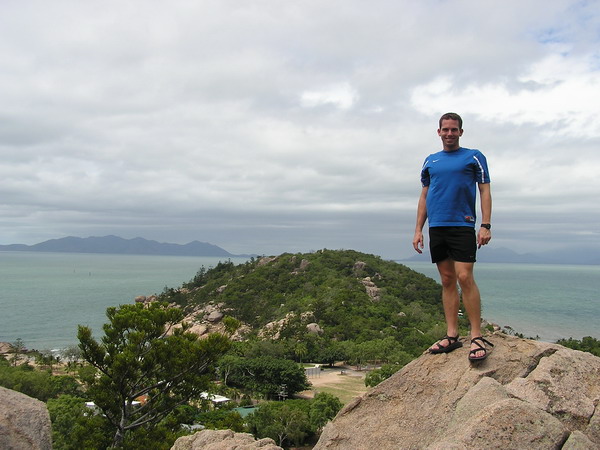
We even tried the phone booths to call back to the States and talk to family.
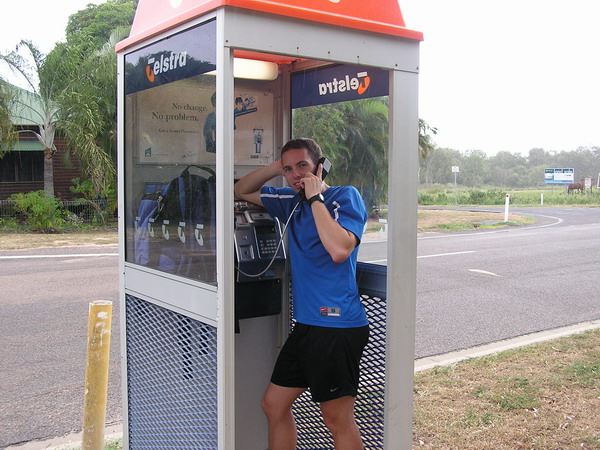
Back in Townsville again, Janine, Anna and I went to the beach. As you can see, the water is a bit different here than in Guam. It also has a barrier to keep the sharks and jellies (jellyfish) away. A bit constraining, but still fun to play in the water.
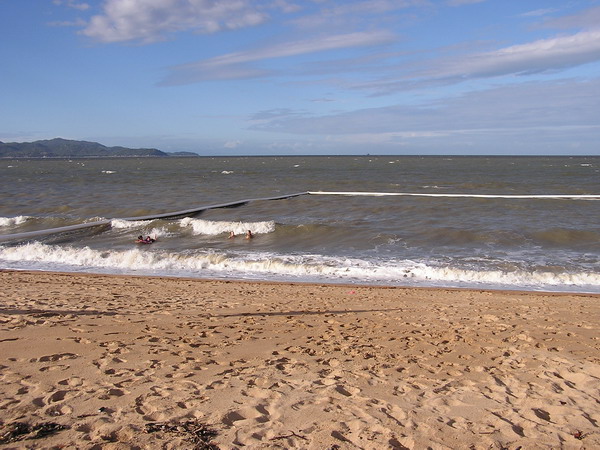
There is some truth to the belief that everyone surfs in Australia. The lifeguards certainly do.
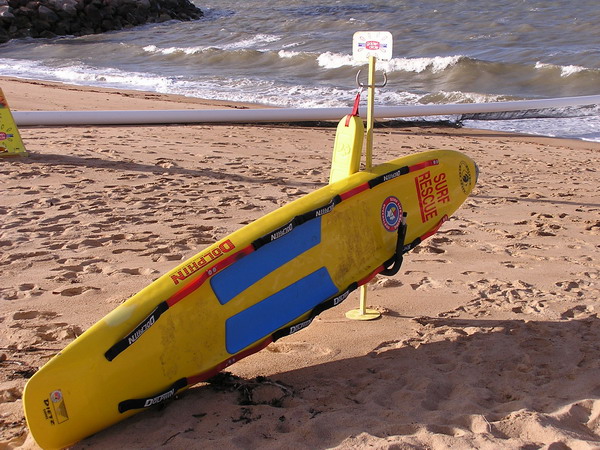
Anna and Janine, taking in the sun.
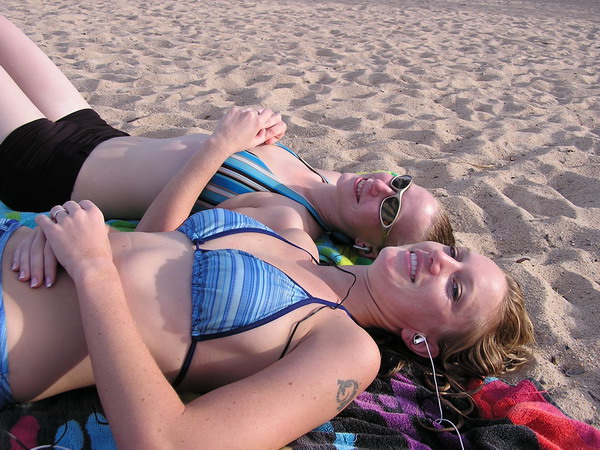
Our last night in Townsville, Anna’s Australian “Mum and Dad” (that she lived with when she was here before), took us out to a very nice dinner. I was glad to have finally met them, after I heard so much about them for so long. They were every bit as nice and welcoming as Anna said they were. That is true for most every Aussie we met. A very warm, open, and welcoming culture.
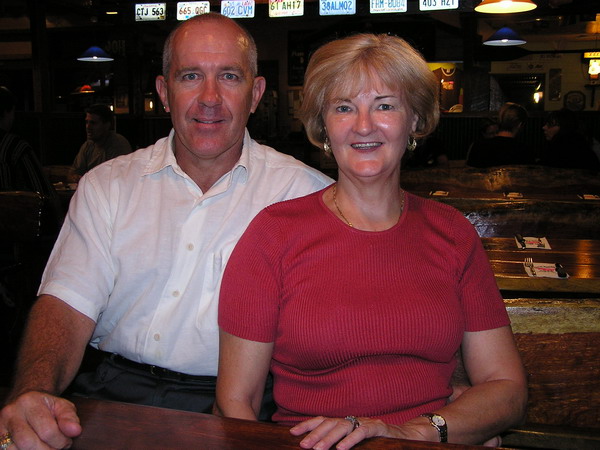
Then we sadly had to part ways and head back to Cairns for another day. This time, we decided to take a trip out to the Great Barrier Reef (which take an hour and a half by boat in most places).
We went to a place called Green Island. Fortunately, there was a very speedy ferry to make the trip in only about 45 min.
While out there, we decided to see how it was to dive and snorkel. It was nice, but surprisingly, didn’t seem a whole lot better than diving in Guam. I am sure there are many places that are amazing to dive on the Great Barrier Reef(it is after all over 2,000 kilometers long), but our choice was less than amazing. However, it was a great day, and while we didn’t see any sharks (as I was hoping), we did run into a number of sea turtles, which are always fun to watch.
So, that concluded out time in Northern Australia. We hopped a domestic flight down to Sydney and began the second week, in what has become one of our top 5 favorite cities in the world.
–Jim
Thailand Part 6: More hilltribe trekking, wats, an orchid farm and the Chang Mai Night Market.
As we lumbered along on our elephant, our guides slide by on a bamboo raft they had built (or at least lashed together) after we left. It was perhaps a more elegant way to travel the river. Don’t get me wrong, we loved the elephant, but were more than ready to get off when we got to our destination.
So, after a lunch break and short siesta in another large hut built to aid visitors we began our trip down the river. No sooner had we started, then a rain that turned into a torrential downpour began. It was almost cold for a while and gave us a better appreciation for the characters in “Forrest Gump” as they survived the seasonal rain in southeast Asia.
Here we are during a break in the rain.
I was even allowed to pilot the craft for a while.
The last night, we stayed in our own small, private hut over the river. At this point in the river, the rapids became too large for the bamboo rafts, and the only watercraft beyond were traditional rubber river rafts or kayaks.
Another view of the place we stayed (which also doubled as a restaurant). However, as they had for the rest of the
trip, our guides provided us with traditional and truly spectacular dishes to our culinary delight. Even I, who am not a “food” person, really appreciated the meals they made for us.
Since we were not burdened with have to make or clean up the meals, we were able to take short hikes in the area to appreciate the views of the cloud forest (as Anna called it).
This is probably just the name of the person who lives here, but I liked the sign.
Yet another symbol of the devotion so many Thais feel for their religion. However, while a vast majority of the country is Buddhist, the missionaries that have visited many of the hill tribes, have converted a number of them to Christianity, but their “traditional” religion (often a form of animism) is still very strong and sometimes intermixed with other faiths.
Another friend we met along the way.
The last day, we used a truck to get us out of the deep jungle. On the way, we saw a number of villages and these two large rocks in the river. No wait, those are elephant butts.
We also stopped by another holy temple. In it, there was a local monk whose embalmed body and wax likeness was on display.
Outside, this row of Buddhas caught my eye.
The last stop on the trek was to a butterfly and orchid farm on the outskirts of Chang Mai. These orchids were very pretty and are my favorite tropical flower.
Anna blended right in.
That concluded our hill tribe immersion experience, but it was quite memorable. If you have a chance to go, I highly recommend it. Our guide, Jai, was of decent from one of the hill tribes (Hmong) and his ability to speak the language (which is linguistically very distinct from Thai, and even from the other hill tribes), move with extensive
local knowledge, training in horticulture and most importantly, his ability to explain and decipher the local customs and practices for us was a VERY enlightening experience.
When we arrived back to our hotel in Chang Mai, we had all afternoon to enjoy ourselves by the pool. Then, we discovered a local dish that is absolutely delicious: mango and sticky rice. After our afternoon snack, we headed down the street for one more Thai massage. This one was not as perfect in terms of setting, just a simple bed and towel, but the price was tough to beat. We had a 2 hour massage for $8 (US) each. Then another delightful dinner, then back to the night market. This time I was armed with my camera, so I can share what it looks like.
Today brought to a close our simply magnificent voyage into Thai culture and living. We loved every minute (well, almost every minute). We would love to come back and perhaps stay a little longer next time.
So, until our next adventure.
–Jim
Thailand Part 5: Northern Thailand and Hilltribe Village Trek
This was without question, our favorite part of the trip. We certainly enjoyed all of it, but this was the most enlightening and unique. It offered a view into a different part of the world that we knew very little about (and quite honestly, still have only scratched the surface).
We chose to go on a 3 day, 2 night trek that included hiking through the jungle, visits with five villages and three tribes, an elephant ride, a bamboo rafting trip, a personal guide (and 2 very able assistants) to give us cultural as well as flora and fauna education.
We started the trek out with a visit to a hot springs. It was too hot to get in, but people used to bring their eggs to boil in the water (it took about 6-7 minutes). Now, the government has disallowed the practice, but it’s still very pretty to watch as the hot water roils from the steam below.
Here is our guide, Jai and I on the jungle trail. Some parts were very easy to pass (like this), and others were a little more rough, but none were too difficult. Since the region was hilly, it made for many up and downs, but our hiking in Guam was good preparation.
The first hill tribe village we came to was a Karen village. In fact, one of our assistant guides, B, was from there.
Here is a picture of B’s older sister working the loom to weave a handbag. Each one takes her about 2 weeks to complete.
Here are more people from the village.
After a brief visit with them, we headed back out on the trail.
Here is the view from the next place we stopped for a drink of water and snack.
Here I am with our guides, from left to right: Beek (I’m afraid I don’t know how to spell his name), me, B, and Jai.
If you look close in the center of this picture you can see the Karen village we had just stopped at. This may give you a better sense of the vastness of the jungle in this part of the country. It reminded me most of the woods in Ontario, where you wouldn’t see another person (or sign of human habitation) for miles.
The next village was a Lahu village. This is the inside of the hut where Anna and I slept. It was owned by a family who allowed tourists to stay there (for a small fee of course). They used to house them in the same house as the family, but to give their visitors a little more privacy and solitude, they built a separate house. As you can see, it can handle quite a few more than our group, but since it was just me and Anna, we got the whole room to
ourselves. Of course, that night there was a typical tropical downpour and the roof right above me had a leak. It wasn’t large, but it was enough to quickly soak the area I was sleeping, so it was fortunate that we could just slide right over, drop the mosquito net and go back to sleep.
This small village is isolated and little to no commerce goes on, so people farm and raise animals for subsistence alone. They also have to thrash their own rice by hand. Here is a woman we were able to watch doing just that:
Another hut in the village. I believe there were about 50 huts in the whole village. It was so small that the children from both this village and the last had to walk to other, larger villages to go to school (sometimes as much as an hour and a half, each way).
Two years ago, the government of Thailand gave these villages the first electricity in the form of solar cells.
They are not terribly powerful, but do allow enough for a couple hours of fluorescent light at night, or an hour of TV or radio.
Here is the outside of the hut we stayed in.
Sometimes, there is very little to do…
The next morning, as we were getting ready for breakfast, a small friend wandered over. Those of you who know me, know that I have a soft spot for cats. In particular those that are undeniably affectionate (even if they are a little dirty…).
Back on the trail, we came across a couple local men who had used dogs to local a large, rat-like creature in this termite hill and were in the process of digging it out to have rat for dinner that night.
Our next unique experience was trip to an elephant camp. Here we hopped on the back of a very large (at least she seemed large to us!) elephant. Our mahout (who is the person dedicated to working with that one animal for its life … this relationship is begun at a very young age for both elephant and boy) guided us for about an hour and a half ride down and through the river to the next village. I can’t say the ride was the most comfortable, but it certainly was a first for both of us.
The mahout probably had a more comfortable location to ride on. I don’t know what the elephant thought, but I know I wouldn’t want someone riding on my head for extended periods of time!
Here are a couple other mahouts returning from their last ride to the next village.
–Jim
Thailand Part 4: Doi Suthep and Chang Mai
The mountain that reminds Chang Mai that it’s in a mountainous region is Doi Suthep. The local legend goes that many centuries ago the local Buddhist temple was given a tiny portion of “the” Buddha’s ashes after he was cremated. This was then placed around the neck of a white elephant. It was released and promptly proceeded to
climb Doi Suthep. Upon reaching the top (or close to), it made several circuits around the area, laid down and died. The king at the time, decided this omen was very significant, buried they elephant there and built Wat Phra That Doi Suthep on that very spot. As such, this has become a very sacred shrine.
Here is a picture of the gilded stupa.
Buddha has many poses. In fact, there is one for each day of the week that roughly mirrors his progression through:
Sunday: Seven Days Looking — after he gained enlightenment
through meditation
Monday: Pacifying the Relatives — he mediated a dispute between
feuding family members
Tuesday: Realizing Nirvana
Wednesday: Holding an Alms Bowl — asking for food
Thursday: Meditating Buddha
Friday: Contemplating Buddha
Saturday: Protected by the Naga King — the large coiled serpent
he is sitting on protected him from a raging storm.
The two Buddhas on the right are not associated with specific days of the week. The one on the far right is known as Victory over Mara and symbolizes Buddha victory over evil or death.
There were several monks who were offering to bless those who desired it.
Here is another example of the alms. The day of the week on which you were born determined how many Baht you needed to give. For reference, right now in 2006, it’s about 38 Thai Baht to 1 US dollar.
On the interior walls, there was a massive mural that depicted the Buddha’s life. This image is of his birth. After he left his mother’s womb, he straight away took 7 steps and the ground he touched became lotus flowers.
For those who aren’t familiar with Buddha’s life let me give a brief historical synopsis: he was born as an Indian to Brahman parents (the highest caste in India) known as Siddhartha Gautama. Growing up, his parents tried to shelter him from the outside world (by literally keeping him confined to the family complex), but eventually, he was allowed out. It was here that he first saw the suffering in the world and could not reconcile what he saw with his Hindu upbringing. So, he began a very ascetic quest to gain a better understanding of the world. He discovered that the ultimate goal in life was enlightenment and the best way to garner that understanding was through meditation. From there, he went on to refine and preach his understanding to others. Today, there are many sects of Buddhism and something like 150 million people in the world are adherents to the faith. Thais consider themselves a pure form of Buddhists (as I am sure the others do as well). The particular form 95% of Thais follow is called Theravada Buddhism.
Here is a woman deep in prayer.
Another monk offering benedictions to all.
Here we are in front of the stupa.
Novice monks as part of their training were required to make three circuits around the stupa.
At the end they offered their thanks.
The bells were also very symbolic. When you ring a bell, you are offering a blessing to those souls in a quasi-purgatory (for lack of a better way to explain it), as they are unable to receive blessings themselves.
Here is Anna offering her share of blessings.
The elephant is a very sacred animal as well. They are used for everything from religious purposes, to working the fields to carrying tourists.
Unfortunately, the city was somewhat obscured by haze, but it was still a pretty view from the top.
Another view of the temple.
Trumpet flowers:
A young novice monk. His robes are a darker color, indicating that he is from a more strict school than the monks with bright orange.
The path leading to the wat is 306 steps.
On the way home, we thought this was a cute way to transport your best friend.
–Jim
Thailand Part 3: Padaung Tribe of Chang Dao (long neck women)
Perhaps the most famous refugees in Thailand are the long neck woman of the Padaung tribe. Their tribe is a sect of the much larger Karen Tribe. They are native to Myanmar (AKA Burma), but several villages have fled persecution there to find a better life in Thailand. While they are not Thai citizens yet, the few that we talked to appeared and said they had a better life in Thailand as a refugee, than back in Myanmar.
To visit them was one of the highlights of the trip. In fact, it was the first stop on the itinerary when we arrived in Chang Mai. We hired a driver and guide to take us to the nearest Padaung refugee camp, about an hour and a half to the north in Chiang Dao.
Here is a girl of 19 years. She along with her 2 younger sisters (15 and 9 years old) came to this village a year ago without any Thai language skill. However, they have readily adapted and are now quite conversational … once you get them going.
In all there were only about 10 families in this small village. They rely entirely on tourists to sustain them.
While their handicrafts are quite nice, it is the admission charged to enter the village that pays for the food.
Here are a few more images of these fascinating women and girls.
While most were Padaung, there were a couple women who were from another tribe. You can see that it’s the large earrings that are distinctive.
We were also invited in to see what the bamboo huts looked like. It was rather spartan, but seemed to meet their need.
Here’s a close up on the coils:
The view from the village was quite beautiful.
Now that you have seen the pictures, and since there are many myths associated with these women, let me dispel a few from what we learned in our research and discovered when visiting and talking to them:
1. The brass coils are traditionally only worn by girls and
women born on Wednesday. However, now that that the tourist
potential has been realized, more woman are allowed to wear
them.
2. The coils don’t “elongate” the neck, per se. It’s a slow
process that gradually displaces the collar bone and rib
cage, thereby making their necks appear longer.
3. Additional coils are added each year. You can get an
approximation of their age by the number of coils worn.
4. When the coils are removed, there is no health danger (e.g.
it won’t kill them). The only concern is that the neck
muscles are atrophied, and are understandably weaker than
the rest of the body. However, there is no proven medical
concern for the removal of the coils.
5. The coils are VERY heavy. Some sets are up to 40 pounds or
more, although they average around 10.
Hopefully, that helps you understand these fascinating people at little better.
–Jim
Thailand Part 2: Amulet market and dinner cruise–Bangkok
After we left Wat Pho, we decided that the last tuk tuk ride was so much fun that we took another.
This time, we went to Amulet Market. At this market, the main theme was religious amulets. Of course, there were plenty of other goods available. Even though we didn’t buy anything, the people watching was fascinating. Here are a couple images of the food market portion:
Eventually, wandering though the market, we wound up at the river. Here is a quintessential Thai boat, the long-tail.
More images from the market:
After we had our fill of Amulet Market, a canal tour of Bangkok sounded like a good thing to do. So, we hired a long-tail boat to guide us through some of the city’s canals. Here is a sampling of the images we found there.
Perhaps because it was Sunday, or perhaps for no reason at all, there were numerous children playing in the water.
Also, the contrast was often sharp, as there were some very nice places like this temple, and others that were barely standing above the water.
This woman was carrying food to either sell somewhere or bring home for a very large family.
We liked the scaffolding (bamboo is a very useful plant).
After our tour of the canals, we were dropped off by Chinatown. Not surprisingly, the market looked very similar to the others we saw.
Here is the view of the city’s skyline from our Bangkok hotel, the Novotel in Siam Square.
That evening we went back to the river for a most enjoyable dinner cruise. The best shot from the night was of this engineering marvel, the King Rama IX Bridge. Our guide said it’s the third longest in the world, after the Golden Gate and another in the USA. However, looks like it’s about the 14th longest cable stayed bridge (also the longest is the Tatara Bridge in Japan).
The next morning, we packed up and flew one hour to the north to explore the Chang Mai province.
–Jim
Thailand Part 1: Arrival, Grand Palace, and Wat Pho–Bangkok
Prologue–This trip was one that offered many excellent photographic opportunities, so if you have a slow connection, these pages may take a little while to load. For that, I apologize. All told, we selected 117 of the 450 we made to share with you. I’ve also included more commentary than normal. This is for a couple reasons, one, it helps explain the pictures (I hope) and two, allows me to share more of the cultural insight I’ve gained that can’t be conveyed through pictures. So, to help ease your reading and downloading, I’ve broken this story down into 6 parts (I wrote these sections at various points in the trips, which is why there’s a bit of shifting perspective).
I hope you enjoy the pictures and commentary. As always, I welcome your comments and feedback.
We began our journey on Saturday (yesterday). It was a mere 7 hour flight here, with a couple hour layover in Manila. 🙂
So, relatively speaking, we’re right next door to Guam.
When we arrived, the FIRST thing we did after checking into our hotel, was indulge in a traditional Thai massage. This was particularly helpful because just the day before I had an exceptionally long and difficult day. So, we treated ourselves to this beloved form of therapy. For those unfamiliar with “Thai” massage, let me give you a brief synopsis. It’s said that Thais here visit the massage parlor more often than the gym. It’s a mixed approach using a combination, hands, fingers, arms, elbows and legs to effectively kneed you into jelly. It’s very “deep” tissue, but instead of going after muscles, they focus on pressure points to “harmonize energy flows.” Whether or not you believe in these, the bending, twisting, pulling and kneading feels more like a passive form of yoga and left me at least feeling much more relaxed. 🙂
After that indulgence, we zipped over the very large and modern mall just around the corner from our hotel.
It’s funny, but some of the best restaurants around are in the malls. The particular one is called MBK Mall and the little Italian place we ate was spectacular! We loved it.
Since it was a Saturday night, we intended to go out after dinner, but once we got back to the room, we hit the proverbial wall and went to bed instead. We woke up this morning feeling quite refreshed as a consequence.
So, our first stop for the day was the Grand Palace. This was the former residence of the King of Thailand and the palace was begun in 1782, the first year that Bangkok was the national capital of Thailand. The grounds encompass more than 100 buildings.
Here’s a view of some of the beautiful spires:
Many statues guard the entranceways.
A fantastic gilded dome:
This picture just doesn’t do Anna justice. For the record, it was INCREDIBLY hot out and the umbrella she’s holding isn’t for rain, it’s for the sun. Yes, it was that hot that a little shade provided a lot of relief.
More statues:
More Thai architecture:
More guards:
Architecture:
Here’s a close up on some of the small glass tiles that give the buildings their luminescent quality.
More images:
Here’s a cluster of young, novice monks as they toured the wat (Buddhist temple). In fact, this particular wat, Wat Phra Kaew, is home to the sacred Emerald Buddha, perched high above the floor on a series of very ornate pedestals.
Picture taking inside was not allowed, so I don’t have any pictures, but the feeling inside was very reverent. The crowd was a mixture of pious Thais paying their respects (any image of Buddha is sacred, but this one holds special significance) and tourists (European, American, and Asian). If you ever happen to visit a Buddhist wat, there’s certain expectation of proper dress and behavior. Here’s a quick list:
1. Always wear modest clothes (long pants, and shirt with
sleeves). While in many places the Thais are too polite
to turn visitors away who are wearing inappropriate
clothes, places like Wat Phra Kaew will not let you in
without them (but also have sarongs/baggy pants for
rent).
2. Do not wear your shoes in the main sanctuary. In fact,
at most homes the same holds true.
3. When sitting in front of a Buddha, it is highly offensive
to point your toes at it. So, when sitting, one must
tuck their feet back behind or underneath them.
Unfortunately, we saw all too many people not following
this in the temple. As an aside, it’s also very rude in
Thai culture to point with your feet, or touch people
with your feet. Anna is quite fond of this custom (she
says it’s a hold over from her childhood when she was
tormented with her sister’s feet. 🙂 )
With those three rules in mind it made our visit that much more enjoyable.
Looks like people with megaphones get the same reaction, regardless of the culture they’re from. 🙂
Yes, this boy is doing what it looks like he’s doing and the white guy on the right is probably as hot as he looks.
Here’s an example of the beautiful Thai script.
A monk in prayer. Most Thai men are expected to shave their heads and become monks at least twice in their lives. Once early in life as a novice monk (with the 7 precepts), and once after school is finished and before marriage (with the 227 precepts). There are female nuns, but are outnumbered 6 to 1 by males. Also Buddhist Thais believe in rebirth, and the good deeds they do today count toward better karma and fewer rebirths leading to eventual passage into Nirvana (enlightenment, or paradise, and the eventual goal of Buddhists to reach).
Monks are seen throughout the streets in Thailand.
An offering:
More holy edifices:
I really liked the blue hue here:
Here’s the main edifice of the Grand Palace. Unfortunately we weren’t allowed inside, but it’s a behemoth of a building and quite impressive.
The King, His Majesty, King Rama IX. His visage is a very common icon throughout the country.
Ok, so he’s not quite the guard at Buckingham Palace, but he’s doing a fine job, nonetheless.
These girls were seeking refuge from the sun under this tree.
After the Grand Palace we headed down the street to see one of the most famous Wats in Thailand, Wat Pho. To get there though, we took a tuk tuk. This venerable form of transportation is an experience in itself. As you can imagine, there are no meters, so you must determine a reasonable fare, before the driver starts out. Of course, the price is always negotiable. Bargaining is a quality that the Thais appreciate (and with a little practice, we did too). That said, we found that several times the drivers would try to tell us that a particular location was closed for a few hours, with the hope that we would then enlist his services to take us on a tour of the city and help himself to a larger share of our money. The solution was to just be persistent and ask that he take us there anyway. Here’s the view from the inside of this “vehicle.” It’s really only slightly larger than a go-kart, so weaving in and around traffic was exciting at times.
Here’s a view from the inside of our first ride in a tuk tuk:
Another tuk tuk in traffic. Compared to the bus and taxis, you can get a better perspective on traffic in Bangkok.
Mopeds are another very popular form of transportation (and in Northern Thailand, they outnumber other vehicles on the roadways). Here’s a young family out for a ride on a pleasant Sunday afternoon:
After our exciting (albeit short) trip to Wat Pho, we arrived to the sacred temple. Here the main focus is an enormous reclining Buddha image. The significance of the pose is that he is about to transition into Nirvana (heaven). Thai Buddhists believe that we all go through multiple lives (reincarnation) and each time the idea is to progress toward eventual enlightenment. Buddha said that he went through 550 iterations until he gained enlightenment.
Here is Buddha reposing:
Also, behind the Buddha is a row of pots to collect alms in. People would take a handful of Baht and deposit one in each jar as they made their way down the line.
I will end this entry here, as it is already way too large.
–Jim
XTerra – Saipan
This weekend, our adventure de jour was a trip to Saipan for the highly touted XTerra off-road triathlon.
I have to say, it did not disappoint in the adventure category!
The one thing I will say this weekend taught me (before I launch into the story in earnest) is that I discovered, I am not a mountain biker. At least, not one to be competitive at these kinds of races!
We began the weekend with the short 120 mile flight over to Saipan on Friday afternoon. We met up with the large Guam contingent (there were 32 athletes from Guam competing … plus family members). Anna decided that she would like to come watch, and support.
Friday night, there was a pre-race dinner for all the athletes, but Anna and I opted out to go back to the SandCastle show. We had already gone New Year’s 2005 when we were last in Saipan, but since Anna had free tickets, it was hard to pass up! 🙂
The show, as usual was excellent. The magic in the show was particularly noteworthy. Since we weren’t allowed to take pictures, I have no visual, but suffice it to say, it was a nice dinner, with a very entertaining magic and dance show.
The next morning, we got up after a full night’s rest. The start time was a late 8:00AM (which meant that it would be plenty warm on the course).
Here I am setting up all my gear.
Some of the other Guam triathletes:
The whole Guam contingent, ready to race!
Here we are in the water. Those of us in the yellow swim caps were doing the “championship” length, while the green means “sport” (or slightly shorter) and the blue is professional. Yes, we had about 10 professional triathletes in our midst. In fact, I actually stayed close to a couple for the first half of the swim … but that was it.
You may be curious, how long is this race? Well, the championship distance was a 1.5K swim, a 30K bike and a 12K run. That converts to about a 1 mile swim, an 18 mile bike and 7.5 mile run. Not too far, right? Well, the terrain we covered made it a little tougher. No worries, though, since I am typing this, AFTER the race, you can tell, I survived. 🙂
The swim course was a 2 lap triangle (each one was 750 meters long). Here is our friend Jude coming out of the water, ready to get started on the bike.
Here I am making my way up the beach.
Another one of our friends, Julian, ready to hop on his bike with a smile.
Coming out of the first transition:
Eric, getting ready to tackle the Saipan mountains:
This is one of the professionals, Jamie Whitmore. She was the 2004 world champion, and has won this race 4 times before. Last year, she came in second. Unfortunately, this year was a repeat, but nonetheless, she’s an amazing athlete who simply flew through this course. This shot Anna took, gives you a good perspective on how people feel throughout. The terrain looks pretty benign, but it was a long, sometimes steep up hill (about 10 miles uphill and 8 miles down). The downhill was almost all technical single track, but more on that later.
Here’s Jamie:
Here’s Keenan, one of the toughest teenagers I know.
Yes, they did have plenty of aid stations that gave us water as we went.
So, once we made it to the top of the mountain (which was just over 1500 feet higher than where we started), we began on the treacherous (for me at least) downhill portion. We had gone through a few technical sections (single track trail, anywhere from a few inches to a few feet wide). Unfortunately for me, I had already fallen a few times by the time I started down the “hard” part. So, I will abbreviate this story a bit and just say that I stopped counting once I had fallen for the 6th time. Eventually, it got so bad, that I simply walked my bike down large portions. That is where it really sunk in that perhaps I am not cut out for the whole mountain biking thing. In all fairness to the sport though, I really haven’t practiced as much as I should. This race was only my second really “technical” ride ever. So, perhaps if I were to go out and do it more often … but I probably won’t be doing that anytime in the near future.
So, while I was walking my bike down, the winner came across the finish line. Here’s a shot of him, Olivier Marceau. Now, this guy is a stud. He won by over 5 minutes and Anna said as he came in, he barely looked winded. Wow.
I, on the other hand, had a long way to go still. So, here I am back in transition (finally), after nearly 3 hours on the bike.
OK, I have no pictures from the run, but it was amazing. Instead of calling it a run though, it is more accurate to call it a scenic hike with running mixed in. At the very beginning of the run, I made a half mile detour (which took my total mileage over 8 miles on the run). Since I knew I was out of ANY contention in the race, I decided to jog/hike the rest of the way. That made the race a lot more enjoyable, as I was able to really enjoy my surroundings. The trail was very rough and at times more difficult than some of our hikes we’ve been on here in Guam! As expected, there was a long uphill section in the beginning and the trail wound it’s way through the jungle. Eventually though, we began to come back down hill by way of some very steep ravines and even through a man made cave. I wish I had a picture to show, but it was very pretty. Anyway, on the way down, I decided it was time to run again, so I picked up the pace and sort of cruised in to the finish. This is another guy I met about a mile from the finish. We started talking and decided to finish the race together.
Perhaps I make it sound like a walk in the park (so to speak), but nevertheless, it was a very challenging race (the toughest triathlon I’ve done, thus far). This one took me about 5 hours, when the last two Olympic distance road triathlons took me 3 hours or less. Those extra 2 hours made a big difference!
These cold, wet towels felt sooo good after the long, hot race.
That ended my XTerra race, and while I don’t need to do this type of race again anytime soon, it was a good experience and I am certainly glad I did it.
Now, to make this post a little longer, I will include some of the sightseeing pictures we took today as we drove around Saipan again.
This little island is called Bird Island.
These are the Bonzai Cliffs. Not only are they striking visually, but there are also some commemorative memorials for the Japanese soldiers of WWII who were killed in Saipan. It was sort of a strange feeling seeing these along side a number of Japanese tourists.
There are also some hardy souls who use the cliffs as a fishing spot as well.
So, that concludes our adventure in Saipan. Even though it was at times painful, it was yet another spectacular weekend.
–Jim
